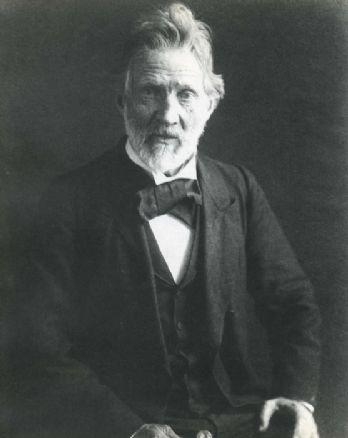Robert Loftin Newman
 Visual Artist
Visual Artist
1827-1912
By: KaSandra Stone
Robert Loftin Newman grew up in Virginia the only son of Robert L. Newman and Sarah J. Matthews. Newman’s father died when he was young, and in 1838 his mother remarried and moved the family to Clarksville. In Tennessee, as a young man, Newman began painting portraits, but his clients repeatedly rejected his work.
In 1846, Newman wrote to the famous artist, Asher B. Durand, requesting acceptance as a student, but Durand refused his request. Fortunately, Newman sold his work Music at the Shop-Board to the American Art Union in New York in 1849 and finally got his chance to study with a master the following year. He spent five months with Thomas Couture in Paris, where he was introduced to the Barbizon School.
He opened a studio in his Clarksville home in 1858 and worked on full-length portraits and pendant portraits for commission. During the Civil War, however, Newman served as a lieutenant of artillery (1861) and as part of Company G of the Fifteenth Virginia Regiment (1864), putting aside his brushes for a time.
 Historians debate where Newman went after the war, but his trail seemed to lead to Nashville and New York. He had a studio on Union Street in Nashville, next door to George Dury’s Studio. The two artists reportedly attempted to open an Academy of Fine Arts but apparently failed. In Nashville, Newman continued painting portraits and offered classes in his studios and at a public school, but in 1873 his mother died, and he moved to New York. He only returned to Nashville once.
Historians debate where Newman went after the war, but his trail seemed to lead to Nashville and New York. He had a studio on Union Street in Nashville, next door to George Dury’s Studio. The two artists reportedly attempted to open an Academy of Fine Arts but apparently failed. In Nashville, Newman continued painting portraits and offered classes in his studios and at a public school, but in 1873 his mother died, and he moved to New York. He only returned to Nashville once.
In New York, Newman quit portraiture and took up small figurative paintings of allegorical, religious, mythological, and obscure objects. He painted madonnas, sapphos, nymphs, and fortune tellers in a highly individualistic style that did not conform to any of the schools of his time. What gained him little appreciation in his day is what artists praise his work today, but his work did gain some fame in his later years. His Little Red Riding hood was exhibited at the National Academy of Design in 1886, he had a one-man show in New York and Boston in 1894, and his Christ Stilling the Tempest was shown at the Paris International Exposition in 1900.
His works would go on to be recognized worldwide, but Newman died of gas asphyxiation in his New York apartment in 1912. Although the artist was gone, the art would go on to be shown around the United States, in Brooklyn, New York, Virginia, Nashville, and Washington D.C. Today, Clarksville honors his memory with a historical marker near Austin Peay State University’s campus.
Additional Resources:
https://tennesseeencyclopedia.net/entries/robert-loftin-newman/


